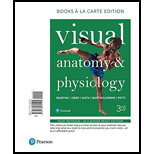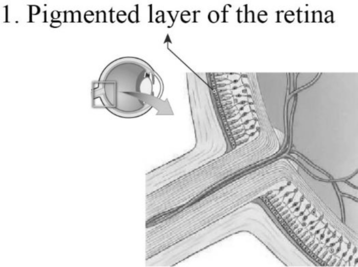
EBK VISUAL ANATOMY & PHYSIOLOGY
3rd Edition
ISBN: 9780134511191
Author: Petti
Publisher: YUZU
expand_more
expand_more
format_list_bulleted
Question
Chapter 15, Problem 1CRQ
Summary Introduction
Introduction: The human eye is one of the sense organs that can be able to respond to light to sense vision. The rods and cones present in the retina of the eye are responsible to allow certain light to be processed as vision and color. This information is transmitted through optic nerve and processed by the brain.
Expert Solution & Answer
Answer to Problem 1CRQ
Pictorial representation: The back of the eye structure in Fig.1 is labeled with the pigmented layer of the retina.

Fig. 1: The pigmented layer of the retina
Explanation of Solution
The retinal pigment epithelium or pigmented layer of the retina is found outside the neurosensory retina. The retinal pigment epithelium nourishes the retinal cells with nutrients and oxygen.
Want to see more full solutions like this?
Subscribe now to access step-by-step solutions to millions of textbook problems written by subject matter experts!
Students have asked these similar questions
What is this?
Molecular Biology
A-C components of the question are corresponding to attached image labeled 1.
D component of the question is corresponding to attached image labeled 2.
For a eukaryotic mRNA, the sequences is as follows where AUGrepresents the start codon, the yellow is the Kozak sequence and (XXX) just represents any codonfor an amino acid (no stop codons here). G-cap and polyA tail are not shown
A. How long is the peptide produced?B. What is the function (a sentence) of the UAA highlighted in blue?C. If the sequence highlighted in blue were changed from UAA to UAG, how would that affecttranslation?
D. (1) The sequence highlighted in yellow above is moved to a new position indicated below. Howwould that affect translation? (2) How long would be the protein produced from this new mRNA?
Thank you
Molecular Biology
Question
Explain why the cell doesn’t need 61 tRNAs (one for each codon).
Please help. Thank you
Chapter 15 Solutions
EBK VISUAL ANATOMY & PHYSIOLOGY
Ch. 15.1 - Prob. 1RCh. 15.1 - Prob. 2RCh. 15.1 - Prob. 3RCh. 15.1 - Prob. 4RCh. 15.1 - Prob. 5RCh. 15.1 - Prob. 6RCh. 15.1 - Prob. 7RCh. 15.1 - Prob. 8RCh. 15.1 - Prob. 9RCh. 15.1 - Prob. 10R
Ch. 15.1 - Prob. 1LOCh. 15.1 - Prob. 2LOCh. 15.1 - Prob. 3LOCh. 15.1 - Prob. 4LOCh. 15.1 - Prob. 1SRCh. 15.1 - Prob. 2SRCh. 15.1 - Prob. 3SRCh. 15.1 - Prob. 4SRCh. 15.1 - Prob. 5SRCh. 15.1 - Prob. 6SRCh. 15.1 - Prob. 7SRCh. 15.1 - Prob. 8SRCh. 15.1 - Prob. 9SRCh. 15.1 - Prob. 10SRCh. 15.1 - Prob. 11SRCh. 15.1 - Prob. 12SRCh. 15.1 - Prob. 13SRCh. 15.1 - Prob. 14SRCh. 15.1 - Prob. 15SRCh. 15.1 - Prob. 16SRCh. 15.1 - Prob. 17SRCh. 15.1 - Prob. 18SRCh. 15.1 - Prob. 19SRCh. 15.1 - Prob. 20SRCh. 15.1 - Prob. 21SRCh. 15.1 - Prob. 22SRCh. 15.1 - Prob. 23SRCh. 15.2 - Prob. 1RCh. 15.2 - Prob. 2RCh. 15.2 - Prob. 3RCh. 15.2 - B. Which layer of the eye would be the first...Ch. 15.2 - Prob. 5RCh. 15.2 - Prob. 6RCh. 15.2 - Prob. 7RCh. 15.2 - Prob. 8RCh. 15.2 - Prob. 9RCh. 15.2 - Prob. 10RCh. 15.2 - Prob. 11RCh. 15.2 - Prob. 12RCh. 15.2 - Prob. 13RCh. 15.2 - Prob. 14RCh. 15.2 - Prob. 15RCh. 15.2 - Prob. 16RCh. 15.2 - Prob. 17RCh. 15.2 - Prob. 18RCh. 15.2 - Prob. 19RCh. 15.2 - Prob. 20RCh. 15.2 - Prob. 21RCh. 15.2 - Prob. 22RCh. 15.2 - Prob. 23RCh. 15.2 - Prob. 24RCh. 15.2 - Prob. 25RCh. 15.2 - Prob. 1LOCh. 15.2 - Prob. 2LOCh. 15.2 - Prob. 3LOCh. 15.2 - Prob. 4LOCh. 15.2 - Prob. 5LOCh. 15.2 - Prob. 6LOCh. 15.2 - Prob. 7LOCh. 15.2 - Prob. 8LOCh. 15.2 - Prob. 9LOCh. 15.2 - Prob. 10LOCh. 15.2 - Prob. 1SRCh. 15.2 - Prob. 2SRCh. 15.2 - Prob. 3SRCh. 15.2 - Prob. 4SRCh. 15.2 - Prob. 5SRCh. 15.2 - Prob. 6SRCh. 15.2 - Prob. 7SRCh. 15.2 - Prob. 8SRCh. 15.2 - Prob. 9SRCh. 15.2 - Labeling: Label the structures in this diagram of...Ch. 15.2 - Prob. 11SRCh. 15.2 - Prob. 12SRCh. 15.2 - Prob. 13SRCh. 15.2 - Prob. 14SRCh. 15.2 - Prob. 15SRCh. 15.2 - Prob. 16SRCh. 15.2 - Prob. 17SRCh. 15.2 - Prob. 18SRCh. 15.2 - Prob. 19SRCh. 15.2 - Prob. 20SRCh. 15.2 - Prob. 21SRCh. 15.2 - Prob. 22SRCh. 15.2 - Prob. 23SRCh. 15.2 - Prob. 24SRCh. 15.2 - Prob. 25SRCh. 15.2 - Prob. 26SRCh. 15.2 - Prob. 27SRCh. 15.2 - Prob. 28SRCh. 15.2 - Prob. 29SRCh. 15.2 - Prob. 30SRCh. 15.2 - Prob. 31SRCh. 15.2 - Prob. 32SRCh. 15.3 - Prob. 1RCh. 15.3 - Prob. 2RCh. 15.3 - A. Name the three tiny bones located in the middle...Ch. 15.3 - Prob. 4RCh. 15.3 - Prob. 5RCh. 15.3 - Prob. 6RCh. 15.3 - Prob. 7RCh. 15.3 - Prob. 8RCh. 15.3 - Prob. 9RCh. 15.3 - Prob. 10RCh. 15.3 - Prob. 11RCh. 15.3 - Prob. 12RCh. 15.3 - Prob. 13RCh. 15.3 - Prob. 14RCh. 15.3 - Prob. 15RCh. 15.3 - Prob. 16RCh. 15.3 - Prob. 17RCh. 15.3 - Prob. 1LOCh. 15.3 - Prob. 2LOCh. 15.3 - Prob. 3LOCh. 15.3 - Prob. 4LOCh. 15.3 - Prob. 5LOCh. 15.3 - Explain the anatomical and physiological basis for...Ch. 15.3 - Prob. 7LOCh. 15.3 - Prob. 8LOCh. 15.3 - Prob. 1ICh. 15.3 - Prob. 2ICh. 15.3 - Prob. 3ICh. 15.3 - Prob. 1SRCh. 15.3 - Prob. 2SRCh. 15.3 - Prob. 3SRCh. 15.3 - Prob. 4SRCh. 15.3 - Prob. 5SRCh. 15.3 - Prob. 6SRCh. 15.3 - Prob. 7SRCh. 15.3 - Prob. 8SRCh. 15.3 - Prob. 9SRCh. 15.3 - Prob. 10SRCh. 15.3 - Prob. 11SRCh. 15.3 - Prob. 12SRCh. 15.3 - Prob. 13SRCh. 15.3 - Prob. 14SRCh. 15.3 - Prob. 15SRCh. 15.3 - Prob. 16SRCh. 15.3 - Prob. 17SRCh. 15.3 - Prob. 18SRCh. 15.3 - Prob. 19SRCh. 15.3 - Prob. 20SRCh. 15.3 - Prob. 21SRCh. 15 - Prob. 1CRQCh. 15 - Prob. 2CRQCh. 15 - Prob. 3CRQCh. 15 - Prob. 4CRQCh. 15 - Prob. 5CRQCh. 15 - Prob. 6CRQCh. 15 - Prob. 7CRQCh. 15 - Prob. 8CRQCh. 15 - Prob. 9CRQCh. 15 - Prob. 10CRQCh. 15 - Prob. 11CRQCh. 15 - Prob. 12CRQCh. 15 - Prob. 13CRQCh. 15 - Prob. 14CRQCh. 15 - Prob. 15CRQCh. 15 - Prob. 16CRQCh. 15 - Prob. 17CRQCh. 15 - Prob. 18CRQCh. 15 - Prob. 19CRQCh. 15 - Prob. 20CRQCh. 15 - Prob. 21CRQCh. 15 - Prob. 22CRQCh. 15 - Prob. 23CRQCh. 15 - Prob. 1CICh. 15 - Prob. 2CICh. 15 - Prob. 3CICh. 15 - Prob. 4CICh. 15 - Prob. 5CICh. 15 - Prob. 6CICh. 15 - Prob. 7CICh. 15 - Prob. 8CI
Knowledge Booster
Learn more about
Need a deep-dive on the concept behind this application? Look no further. Learn more about this topic, biology and related others by exploring similar questions and additional content below.Similar questions
- Molecular Biology You discover a disease causing mutation (indicated by the arrow) that alters splicing of its mRNA. This mutation (a base substitution in the splicing sequence) eliminates a 3’ splice site resulting in the inclusion of the second intron (I2) in the final mRNA. We are going to pretend that this intron is short having only 15 nucleotides (most introns are much longer so this is just to make things simple) with the following sequence shown below in bold. The ( ) indicate the reading frames in the exons; the included intron 2 sequences are in bold. A. Would you expected this change to be harmful? ExplainB. If you were to do gene therapy to fix this problem, briefly explain what type of gene therapy youwould use to correct this. Please help. Thank youarrow_forwardMolecular Biology Question Please help. Thank you Explain what is meant by the term “defective virus.” Explain how a defective virus is able to replicate.arrow_forwardMolecular Biology Explain why changing the codon GGG to GGA should not be harmful. Please help . Thank youarrow_forward
- Stage Percent Time in Hours Interphase .60 14.4 Prophase .20 4.8 Metaphase .10 2.4 Anaphase .06 1.44 Telophase .03 .72 Cytukinesis .01 .24 Can you summarize the results in the chart and explain which phases are faster and why the slower ones are slow?arrow_forwardCan you circle a cell in the different stages of mitosis? 1.prophase 2.metaphase 3.anaphase 4.telophase 5.cytokinesisarrow_forwardWhich microbe does not live part of its lifecycle outside humans? A. Toxoplasma gondii B. Cytomegalovirus C. Francisella tularensis D. Plasmodium falciparum explain your answer thoroughly.arrow_forward
- Select all of the following that the ablation (knockout) or ectopoic expression (gain of function) of Hox can contribute to. Another set of wings in the fruit fly, duplication of fingernails, ectopic ears in mice, excess feathers in duck/quail chimeras, and homeosis of segment 2 to jaw in Hox2a mutantsarrow_forwardSelect all of the following that changes in the MC1R gene can lead to: Changes in spots/stripes in lizards, changes in coat coloration in mice, ectopic ear formation in Siberian hamsters, and red hair in humansarrow_forwardPleiotropic genes are genes that (blank) Cause a swapping of organs/structures, are the result of duplicated sets of chromosomes, never produce protein products, and have more than one purpose/functionarrow_forward
- A loss of function mutation in Pitx1 enhancers can cause (blank) Removal of Pitx1 exons and growth of ectopic hindlimbs, growth of extra ectopic forelimbs, loss of forelimb specification and development, and loss of hindlimb specification and developmentarrow_forwardHox1a most likely contributes to (blank) patterning in the developing embryo? Ventral, posterior, limb or anteriorarrow_forwardSelect all of the following that can help establish Hox gene expression boundaries (things that affect Hox and not things that Hox affects). Retinoic acid, anterior/posterior axis, fibroblast growth factors, vagal neural crest, and enhancersarrow_forward
arrow_back_ios
SEE MORE QUESTIONS
arrow_forward_ios
Recommended textbooks for you
 Human Anatomy & Physiology (11th Edition)BiologyISBN:9780134580999Author:Elaine N. Marieb, Katja N. HoehnPublisher:PEARSON
Human Anatomy & Physiology (11th Edition)BiologyISBN:9780134580999Author:Elaine N. Marieb, Katja N. HoehnPublisher:PEARSON Biology 2eBiologyISBN:9781947172517Author:Matthew Douglas, Jung Choi, Mary Ann ClarkPublisher:OpenStax
Biology 2eBiologyISBN:9781947172517Author:Matthew Douglas, Jung Choi, Mary Ann ClarkPublisher:OpenStax Anatomy & PhysiologyBiologyISBN:9781259398629Author:McKinley, Michael P., O'loughlin, Valerie Dean, Bidle, Theresa StouterPublisher:Mcgraw Hill Education,
Anatomy & PhysiologyBiologyISBN:9781259398629Author:McKinley, Michael P., O'loughlin, Valerie Dean, Bidle, Theresa StouterPublisher:Mcgraw Hill Education, Molecular Biology of the Cell (Sixth Edition)BiologyISBN:9780815344322Author:Bruce Alberts, Alexander D. Johnson, Julian Lewis, David Morgan, Martin Raff, Keith Roberts, Peter WalterPublisher:W. W. Norton & Company
Molecular Biology of the Cell (Sixth Edition)BiologyISBN:9780815344322Author:Bruce Alberts, Alexander D. Johnson, Julian Lewis, David Morgan, Martin Raff, Keith Roberts, Peter WalterPublisher:W. W. Norton & Company Laboratory Manual For Human Anatomy & PhysiologyBiologyISBN:9781260159363Author:Martin, Terry R., Prentice-craver, CynthiaPublisher:McGraw-Hill Publishing Co.
Laboratory Manual For Human Anatomy & PhysiologyBiologyISBN:9781260159363Author:Martin, Terry R., Prentice-craver, CynthiaPublisher:McGraw-Hill Publishing Co. Inquiry Into Life (16th Edition)BiologyISBN:9781260231700Author:Sylvia S. Mader, Michael WindelspechtPublisher:McGraw Hill Education
Inquiry Into Life (16th Edition)BiologyISBN:9781260231700Author:Sylvia S. Mader, Michael WindelspechtPublisher:McGraw Hill Education

Human Anatomy & Physiology (11th Edition)
Biology
ISBN:9780134580999
Author:Elaine N. Marieb, Katja N. Hoehn
Publisher:PEARSON

Biology 2e
Biology
ISBN:9781947172517
Author:Matthew Douglas, Jung Choi, Mary Ann Clark
Publisher:OpenStax

Anatomy & Physiology
Biology
ISBN:9781259398629
Author:McKinley, Michael P., O'loughlin, Valerie Dean, Bidle, Theresa Stouter
Publisher:Mcgraw Hill Education,

Molecular Biology of the Cell (Sixth Edition)
Biology
ISBN:9780815344322
Author:Bruce Alberts, Alexander D. Johnson, Julian Lewis, David Morgan, Martin Raff, Keith Roberts, Peter Walter
Publisher:W. W. Norton & Company

Laboratory Manual For Human Anatomy & Physiology
Biology
ISBN:9781260159363
Author:Martin, Terry R., Prentice-craver, Cynthia
Publisher:McGraw-Hill Publishing Co.

Inquiry Into Life (16th Edition)
Biology
ISBN:9781260231700
Author:Sylvia S. Mader, Michael Windelspecht
Publisher:McGraw Hill Education
Visual Perception – How It Works; Author: simpleshow foundation;https://www.youtube.com/watch?v=DU3IiqUWGcU;License: Standard youtube license